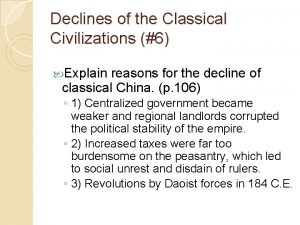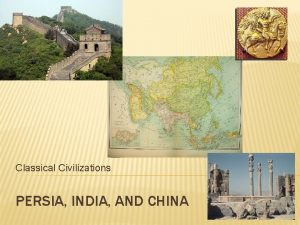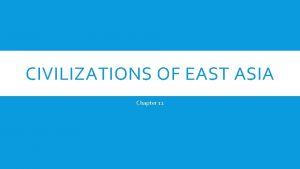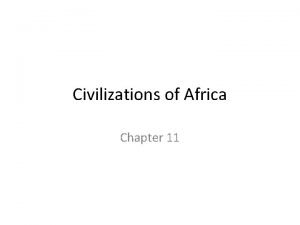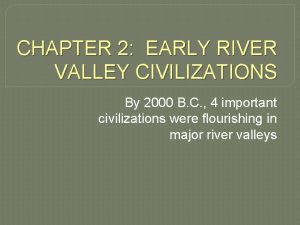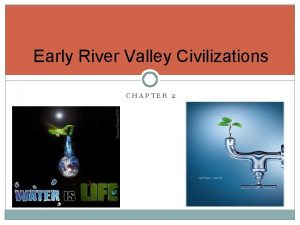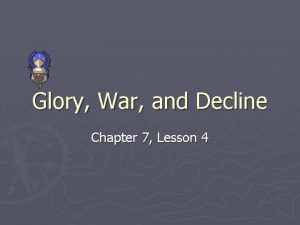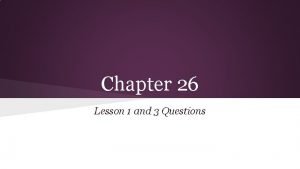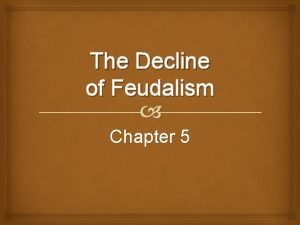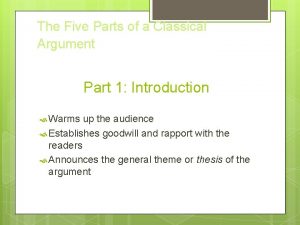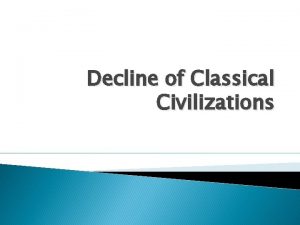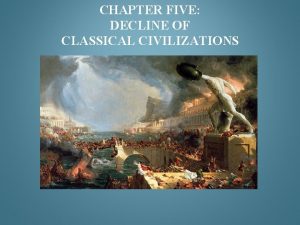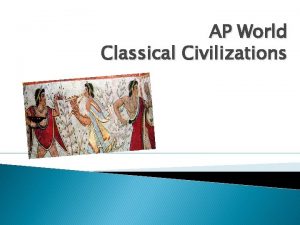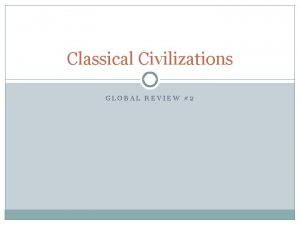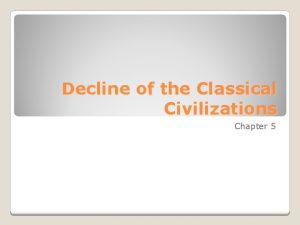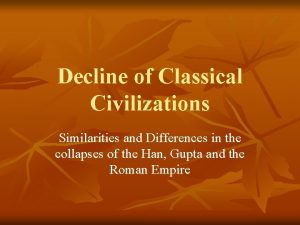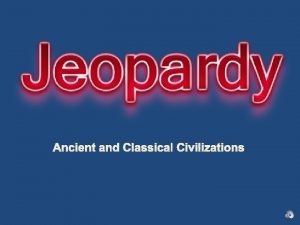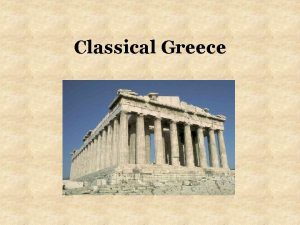CHAPTER FIVE DECLINE OF CLASSICAL CIVILIZATIONS Ms Sheets













- Slides: 13

CHAPTER FIVE: DECLINE OF CLASSICAL CIVILIZATIONS Ms. Sheets AP World History

CLASSICAL TRADE • Due to large-scale empires, volume and distance of trade increased 1) Indian Ocean Trade • East Africa to Southern China • Items traded: Chinese pottery, Indian spices, and Indian/African ivory • Depended on monsoons and currents; lateen (triangular) sail developed to maneuver; small boats 2) Silk Road Trade • Han China to Mediterranean • Exchange of Western/Eastern goods, religions, technology (horse stirrup), disease • Caravanserai (inns) develop 3) Trans-Saharan Trade (pre-Islamic) • Across the Sahara: camels (1 st c. CE) and camel saddle • Items traded: salt, palm oil, olives, wheat, wild animals, slaves

COMMON THEMES IN CLASSICAL CIVILIZATIONS Ø Territorial expansion Ø Efforts to integrate new territories (Rome, India, Han) • Create territorial and social cohesion Ø Unification • China (centralization; Confucianism) • India (religious values) • Greece (cultural achievements) • Rome (citizenship) Ø Decline

CLASSICAL INDIA Ø Expansion • Mauryans expand to almost all of Indian subcontinent • Guptas used localized governments in new territories Ø Integration • Used Hinduism to expand (Buddhism unappealing) • Used the caste system to create social distinctions Ø Decline • Invasions by White Huns • Decentralization grows weak; independent kingdoms created • After 600, Islam enters India

CLASSICAL CHINA Ø Expansion • West and south, rice-growing regions Ø Integration • One language (written and spoken) • Strong centralized government (Qin and Han) Ø Decline • 100 CE – 220 CE • Heavy taxes; poor harvests; weak emperors • Nomadic invasions by Huns (Xiongnu) and other nomadic tribes • 184 CE: Yellow Turban Rebellion • Three Kingdoms Era (disorder and political decentralization), then Sui dynasty by 589 CE

CLASSICAL GREECE Ø Expansion • Expansion is cultural, rather than territorial Ø Integration • Use of common language • Persian War helped to integrate citystates, unite against common enemy Ø Decline • Ultimately default to city-state identity, geographic unity is challenging • Peloponnesian War weakens Athens • Macedonian invasion weakens all city-states • Greek culture (Hellenism) continues

CLASSICAL ROME Ø Expansion • Massive expansion under Roman Republic Ø Integration • Cultural tolerance, common law, and citizenship (males) for conquered peoples • Allow regional diversity Ø Decline • Golden Age ends 180 CE • Decline is complex (economy, plague, leadership, latifundia, invasions) • Split of East and West (4 th century)

RELIGION DURING THE CLASSICAL DECLINE • Buddhism – Rejected by Gupta India – Rapid expansion into Southeast and East Asia • Christianity – Rapid emergence and expansion into Mediterranean and Europe – 313 CE: Constantine issues Edict of Milan to permit Christianity in Rome • Islam – 610 CE: Created by Muhammad – Religion spreads rapidly through conversions – Empire spreads through conquering • Hinduism – Supported by Gupta India – Supported by caste system

RELIGION DURING THE CLASSICAL DECLINE, CONT. • All major religions see an increase in participants – Why? Chaos of classical decline causes people to gravitate towards a religion that focuses upon afterlife, leaving chaos of current world behind, and salvation • Religions spread through missionaries (monks, nuns), merchants • Belief systems affected gender roles – Change in women’s roles: Christian and Buddhist nuns were able to exercise power and influence within their communities • Other religions continued outside of core civilizations – Shamanism and animism – Ancestor veneration

OTHER CLASSICAL CIVILIZATIONS • Japan – Developed in great isolation • Language is unrelated to Chinese – As populations grew, communities were separated by mountainous terrain – Eventually developed into various aristocratic clans – Agricultural; excellent iron-work – Shintoism developed: “way of the gods, ” animistic religion (spirits are imbedded within nature)

POLYNESIAN COMMUNITIES • Polynesia – People originate from Southeast Asia – Remarkable migrations (gradual) – Between 1500 BCE - 1000 BCE: Migration to islands (Fiji, Samoa) – Continue to move to Hawaii by 300400 CE using giant canoes – Isolated development, and no written records – Highly stratified class system under powerful kings – Agricultural communities, limited technology – Cultivated transplanted foods and domesticated animals as they moved

MESOAMERICAN CIVILIZATIONS • Olmecs (1500 BCE – 100 BCE) – First major civilization in Mexico; “mother civilization” – 800 BCE: Settled in Central Mexican river valley – Agriculture (corn, potatoes) – Domesticated animals – Religious statues (Olmec heads) – Disappeared by 100 BCE • Maya (2000 BCE – 900 CE) – – On Mexican peninsula by 400 CE Most advanced culture in region Pyramid shaped temples Only writing system of Meso. America – Religion was very complex

 What caused the decline of classical civilizations
What caused the decline of classical civilizations The two classical civilizations of ancient india were the
The two classical civilizations of ancient india were the Lesson 1 early civilizations
Lesson 1 early civilizations Chapter 11 civilizations of east asia
Chapter 11 civilizations of east asia Chapter 11 section 1 early civilizations of africa
Chapter 11 section 1 early civilizations of africa Similarities between inca maya and aztec
Similarities between inca maya and aztec Chapter 2 early river valley civilizations
Chapter 2 early river valley civilizations Chapter 2 early river valley civilizations
Chapter 2 early river valley civilizations Chapter 26 civilizations in crisis the ottoman empire
Chapter 26 civilizations in crisis the ottoman empire Chapter 7 lesson 4 glory, war, and decline answers
Chapter 7 lesson 4 glory, war, and decline answers Chapter 26 lesson 1 the decline of the qing dynasty
Chapter 26 lesson 1 the decline of the qing dynasty The decline of feudalism chapter 5 answer key
The decline of feudalism chapter 5 answer key Cicero rhetorical devices
Cicero rhetorical devices Classical arrangement of argument
Classical arrangement of argument
